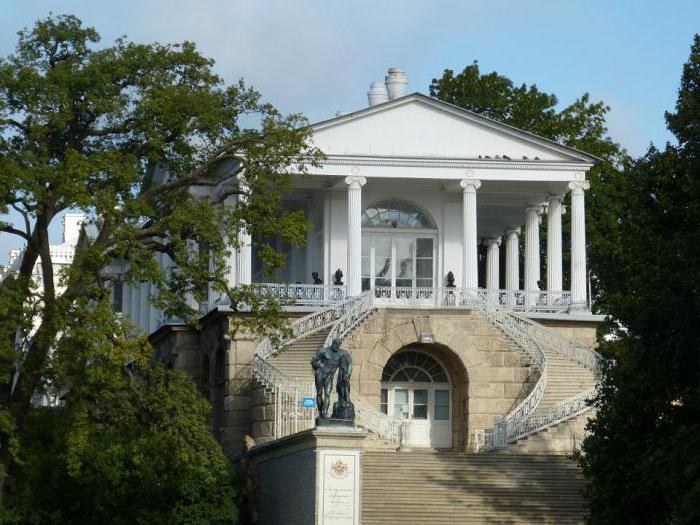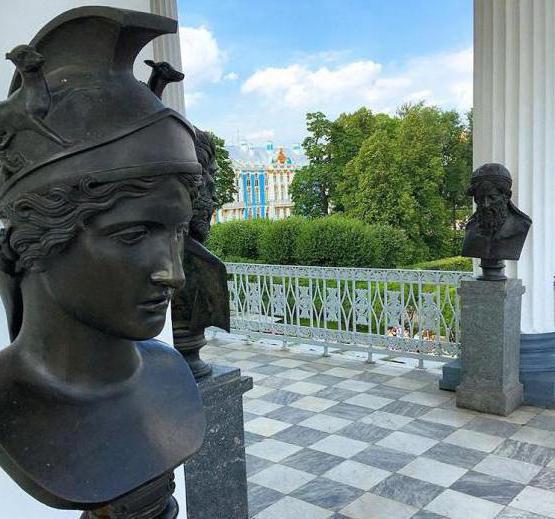The Cameron Gallery in Tsarskoye Selo was built during the reign of Catherine II, when the palace park underwent the greatest changes. The empress was carried away with his accomplishment as zealously as her predecessor Elizaveta Petrovna by re-equipping the Catherine Palace. Until her death, the Grand Duchess led the beautification and decoration of the park.
Around the middle of her reign (1779), Catherine II invited the London architect Charles Cameron to erect park buildings in the "antique style" of the summer imperial residence. So an amazing ensemble (1783-1786) appeared, consisting of a term (Cold Baths) with Agate rooms, the Hanging Garden and the Cameron Gallery in Tsarskoye Selo, a description with a photo of which is given in the article.
New board - new style
Considering the Grand Tsarskoye Selo Palace to be old-fashioned, Catherine the Great often called it “whipped cream”. With the beginning of her reign, a new style rapidly developed - Russian classicism. Antique proportions, elegant simplicity of outlines and a moderate, almost ascetic design of architectural structures replaced the bizarre decor and the abundance of intricate elements of the Elizabethan Baroque. The characteristic features of mature classicism are superbly presented in the configuration and decoration of the Cameron Gallery in Tsarskoye Selo. Charles Cameron possessed the style of antiquity unsurpassed, and he managed with special grace to embody the atmosphere of the historical era in the complex.
Roman term specialist
Why did the empress invite this particular English architect? Cameron worked in the direction of classicism long before the style came to Russia. He was considered an architect with the highest level of professional skill and knowledge. In addition, from 1766 to 1779 he lived in Italy, where he studied the intricacies of ancient architecture. He was especially interested in Roman terms, the scientific work of which he began to write in London. For more than ten years, Cameron personally took measurements, drawings, drawings of Roman buildings and architectural elements, which were included in his very thorough work "The Baths of the Romans." His in-depth knowledge was embodied in the ensemble of Cold Baths, the Hanging Garden and the gallery.

The design did not immediately begin to be named after the architect, but only in 1885, when the Zodchiy magazine published an article by the researcher of the history of architecture N. Petrov, who repeatedly called the gallery in Tsarskoye Selo Cameronova.
Location and architectural features
In 1780, the architect began designing the complex in Tsarskoye Selo Park, which reproduced the Roman terms thoroughly studied by him on a reduced scale. The ensemble begins on the eastern side of the palace with the two-story Cold Baths building. They are connected by an oval loggia-loggia to the Hanging Garden, which leads to a long gallery that ends at the lake in the park with an impressive staircase. Since the gallery building is located on a gentle terrain, the hewn stone base rises significantly in the direction of the lake, and the height of the building by the park staircase is equal to the height of the palace, although this is not noticeable due to the sloping terrain.
The design looks majestic and elegant at the same time thanks to the original idea of the architect. The effectiveness of the structure is based on the principle of contrasts, which is clearly visible in the photo of the Cameron Gallery in Tsarskoye Selo. The first floor is made of pudost stone (tuff lime), resembling a pumice-like porous texture and giving the object a noble appearance of “antiquity”. In contrast to this fundamental basis, the snow-white second floor with 44 slender antique columns seems airy and weightless.
Pudost stone also served as the material for the arched basement of the Hanging Garden and the exterior decoration of the first floor of the Cold Baths, which creates a harmonious integrity of the entire ensemble.
Ground Floor Rooms and Colorful Garden
Inside the Cameron Gallery in Tsarskoye Selo has undergone changes only in the premises of the first floor. Converted halls are now intended for temporary exhibitions. Once upon a time there were maid of honor apartments. Therefore, the kindergarten adjacent to the building is called Freylinsky. A charming place for secluded walks was also designed by Cameron, and the younger Bush, the son of the genius Tsarskoye Selo gardener, was engaged in plant design. Due to the abundance of brightly flowering plants, the garden was also called Tsvetnoy.
Second floor with colonnade
The design, as if reigning, dominates the surrounding landscape. The glazed pavilion of the upper tier, surrounded on four sides by wide open terraces and cannulated columns, was conceived as a belvedere for the contemplation of nature and philosophical meditations of the empress. Therefore, from any place on the open terraces you can see a wonderful view of the park. This was one of Catherine II's favorite places, and she often took walks around the Cameron Gallery in Tsarskoye Selo.
Stairs
As the completion of the entire architectural ensemble, Cameron planned a wide granite staircase descending from the first floor to the park. The only change Catherine made to the project was the wish that the steps lead to the colonnade of the second floor. The problem was solved by the architect very elegantly: two swinging stairs symmetrically in a semicircle frame the arched doorway of the first floor. The composition looks so harmonious that it can be considered an independent masterpiece of architecture.
Creation is crowned with bronze sculptures of Hercules Farnessky and Flora, mounted on pylons on both sides of the steps. Cameron ordered these two copies of marble prototypes from the National Neapolitan Museum during the construction of the complex.
Sculpture collection
The Empress intended to furnish the gallery with statues. So it was customary to decorate the palaces from the time of the late Renaissance. In the year of completion (1787), Catherine ordered the installation of eight rather large compositions made of marble and bronze on the terraces. Thanks to the property description of the Cameron Gallery in Tsarskoye Selo, which is stored in the archives of the palace, we can accurately say what kind of statues they are. All were copies of the masterpieces of Italian and French sculptors, among which was the equestrian statue of Louis XIV and Voltaire sitting in an armchair.
A year later (1788), on the southern facade of the gallery, at the behest of Catherine, several busts were exhibited, among which was an image of the ancient Roman philosopher and playwright Seneca. It was no coincidence: the Empress knew well and often quoted the works of the thinker.
A selection of bronze busts
With considerable difficulty, Cameron managed to convince the highest customer to free the colonnade from eight beautiful, but too bulky sculptures. Three years later they were installed in the Freylinsky kindergarten. And it was decided to decorate long transitions exclusively with busts of outstanding personalities and characters of ancient mythology, executed in bronze. The empress herself decided whose sculptural images deserve a place in her collection. So there was a kind of exhibition of remarkable portraits, inextricably linked with the Cameron Gallery in Tsarskoye Selo. Description and reviews of this exposition are included in many publications on art criticism - both domestic and foreign.

The colonnade was gradually filled with busts of gods, heroes, poets, thinkers, emperors, political figures. The prototypes were the heads of famous statues of ancient Rome and Greece of the Renaissance and later times. Some portraits were ordered separately. Plaster models were performed mainly by Italian sculptors, and casting was carried out in the workshops of the Academy of Arts of St. Petersburg. Also from Europe, courtiers brought ready-made pieces suitable for the Catherine collection. The exposition has 69 busts. In a careful long selection of exhibits, there were some interesting stories and incidents.
Occasional busts
Thunder peaks hit St. Petersburg when in the summer of 1790 the Swedish fleet broke through from the capture of the Russian squadron. The victory was near, and Catherine II ordered that day a bust of the legendary Achilles, whom Alexander the Great honored. The empress also idealized the image of the hero of the Trojan War and deeply sympathized with the ancient Greek king, feeling with him the identity of many properties of character. Much later, the bronze statue by its attributes was defined as the image of the god of war Ares. It is possible to perceive a certain mysterious meaning, given the moment at which the statue was ordered.
When the French state was embraced by the revolution for two years, the Russian ruler in 1791 ordered a bust of the great commander Caesar - the pacifier of the peoples of Gaul (modern France). She believed that that rebellious lawlessness would bring the country to a state of savagery. Then the colonnade was decorated with sculptural images of the god of light Apollo, the fearless hero Hercules, the bearers of wisdom and enlightenment: poets, writers, philosophers, orators. This contained a deep symbolism, perfectly understood by then contemporaries.
Rejected Idols
The French Revolution encouraged Catherine II to put in her gallery busts of wise statesmen, politicians and progressive people who contributed to the pacification of peoples. She compiled and approved a list of such personalities. By 1794, the sculptural portraits of Marcus Aurelius, Scipio Africanus, Titus, Germanicus, Vespasian, Septimius Severus were ready. For casting there were busts of Caracalla and Tiberius. But the ruler decided that bronze portraits of the wayward libertine of Caracalla and tyrannical Tiberius did not belong in her collection. In exchange for them, perhaps to please the old republican interests, she ordered images of Mithridates and Brutus. However, the news that came about the execution of the French king prompted the empress to finally abandon the republican thoughts, and ordered to remove Brutus’s bust from the gallery. Last on her list was the image of Lomonosov.
On this, by the middle of 1793, the complete register of statues was completed. The last busts were cast in the period 1794-1796 from plaster models, which Cameron ordered from the talented Italian sculptor Concezio Albani. The installation of bronze statues was completed shortly before the death of the Great Empress.
Another sculpture of the Cameron Gallery in Tsarskoye Selo was a composition installed at the end of the 19th century: a small copy of the monument to the Great Sovereign on Nevsky Prospekt.
After the German occupation of Leningrad, the entire palace complex was significantly damaged. In the difficult post-war years (1946-1947), the gallery was restored one of the first. The careful work of the restorers thoroughly reproduced its original appearance, which allows us to admire this magnificent example of Russian classicism today.